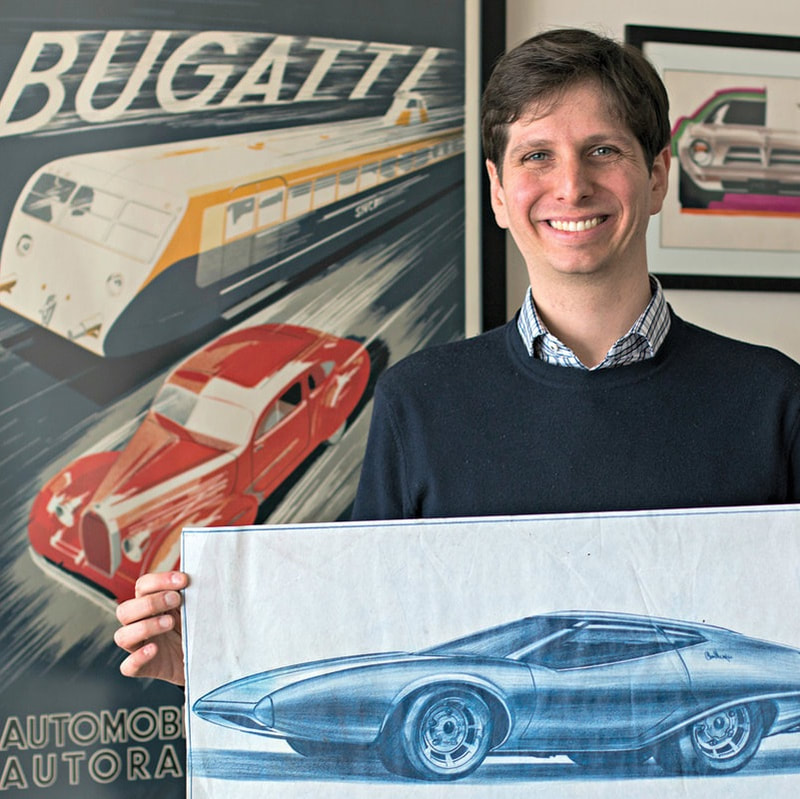|
Nov/Dec 2019 edition Issue #8 AutoMobilia Resource Magazine Michael Umansky In early motor racing, few personalities made a greater impact than the larger-than-life Erwin George “Cannon Ball” Baker. Best known today as the namesake inspiration for Brock Yate’s Cannon Ball Run. Baker in his day was a highly accomplished racing driver, famous for setting over 140 car and motorcycle point-to-point speed records. A master promoter, many manufacturers took Baker up on his “no record, no pay” guarantee and hired him to set records and win publicity for their vehicles. It’s in this context that Baker formed a lifelong professional relationship (and apparent personal friendship) with automotive executive Jim Watson. Like many automobilia collectors, I spend an inordinate amount of time hunting for unique and interesting finds on eBay. Some years ago, I stumbled upon an auction listing for a small stack of vintage Cannon Ball Baker documents with a description that included only a few short sentences and some blurry photos. I took a chance on placing a bid and was more than amazed by what I received when I won the auction. Spanning 25 years from 1928-1953, the collection includes over 25 Cannon Ball Baker related pieces including one-of-a-kind correspondence letters, an early telegram, company magazines and newsletters, newspaper clippings, promotional brochures, photographs and even a personal Christmas card. Jim Watson saved all of these mementos from his time working with Baker and they originate from his estate. Some of the brochures have suffered heavy water damage with staining, large tears and pages stuck together. It’s nothing short of a miracle these items have survived at all. The letters and documents offer a unique new perspective on Cannon Ball Baker’s story, from his time as an active racer chasing speed-distance records to his active work with automakers well past the typical retirement age. The most interesting piece in the collection is arguably a Chrysler Corporation letter dated 1931 that Sales Promotion Manager Burch E. Greene sent to Jim Watson. Greene was apparently very interested in hiring Cannon Ball Baker for a speed-distance run to promote Chrysler automobiles. However, the decision would require the approval of Mr. Chrysler (presumably Walter Chrysler), who had signed an agreement as part of a safety committee to have no involvement in promoting or encouraging speed contests from one city to another. The letter also hints that a previous conflict Baker had with a Chrysler executive named Rollie during his previous time at Willys-Overland would be another “stumbling block” to moving forward. Another unique piece is a September 1928 letter that Watson addressed to Baker while employed at the Franklin Motor Company. The letter congratulates Baker on a successful Pikes Peak run and shares his excitement around a planned speed record attempt to promote the Franklin marque. A Franklin promotional flyer from a month later celebrates that Baker did complete that record-setting run from Columbus to Marietta Georgia despite inclement weather. This was much to the excitement of the 32 Franklin dealers who attended the after-party event. In the 1940s, Watson moved to Nash Motors and continued his close collaboration with Cannon Ball. A two-page 1947 letter from a Nash Zone manager to Watson describes in great detail a publicity tour that Baker took throughout Boston and Connecticut. The trip included giving a series of talks on road safety, photo ops with local officials and a visit to the Indian Motorcycle plant. A 1949 internal Nash memo suggests that Baker’s work with the company extended beyond publicity into vehicle and parts development. The memo indicates that a carburetor modification proposed by Baker to improve fuel economy was actually found to be dangerous in testing and would not be implemented. The last item in the collection is a typed letter dated 1953 from Baker to Watson, hand signed using his other nickname “Bake”. Of all of the pieces, this letter offers the greatest insight into Baker’s spirit and personality. Sadly, it also hints that Baker and Watson had drifted apart in their later years: “It is beginning to look that it is very likely I will hook up with one of your strongest competitors. Remember, I am still working. I am not quitting. I intend to wear out, not rust out. And the doctor says my health is 100%. If I make the switch, Jim, it is very likely I will bump into you somewhere along the line. You and I haven’t had a sit-down, heart-to-heart talk for a long time, and I would surely like to have that happen, but I don’t see how we are going to do it. You are busy and so am I”. Vintage letters and documents are an interesting area of the automobilia hobby and can be very collectible. Early company letterheads often feature beautiful graphics and artistic type fonts which display very nicely. Values on quality vintage pieces can range from around $10 for a simple company correspondence letter up to thousands of dollars for important documents signed by noted historical figures. The value of this archive is difficult to assess as it is truly a one of a kind collection. The personal signed letter would have a greater value if it were signed earlier in his career and using the full “Cannon Ball Baker” rather than “Bake”. I would suggest a value of between $500 and $1500 to the right collector, though historic value far outweighs monetary in this case. Michael Umansky To read more great columns like this one from Cannon Ball Baker expert Michael Umansky...
|
Cannon Ball BakerMichael Umansky is a lifelong automotive enthusiast with a passion for cars of all makes, models and eras. ArchivesCategories |
Home
|
Subscribe
|
|
Automobilia Resource LLC
1217 Cape Coral Pkwy East #178 Cape Coral, Florida 33904 Main office: 954-579-5280 Subscriptions: 224-558-8955 Editor: 631-258-9887 |
Copyright © 2023 Automobilia Resource LLC. All Rights Reserved









 RSS Feed
RSS Feed